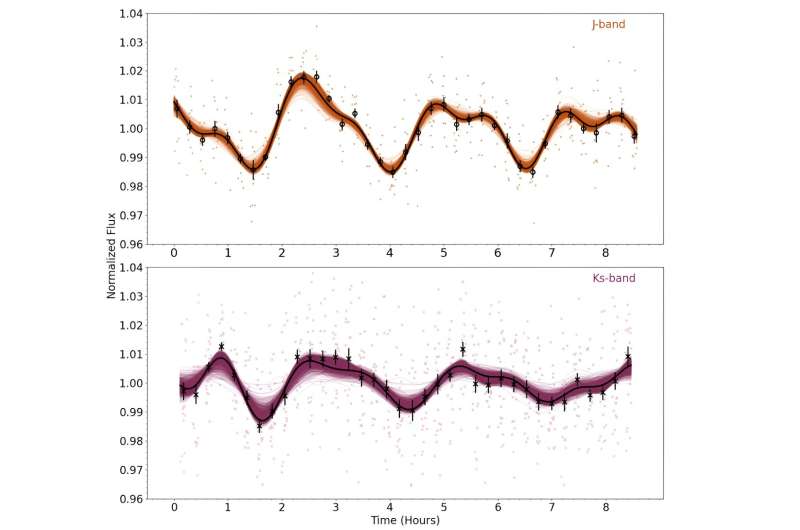March 4, 2024 report
This article has been reviewed according to Science X's editorial process and policies. Editors have highlighted the following attributes while ensuring the content's credibility:
fact-checked
preprint
trusted source
proofread
Observations find evidence of patchy cloud layers in the atmosphere of a nearby planetary-mass object

Astronomers have performed multi-wavelength photometric observations of a nearby planetary-mass object known as SIMP J013656.5+093347. Results of the observational campaign, presented February 22 on the pre-print server arXiv, suggest that the object hosts patchy cloud layers in its atmosphere.
Discovered in 2006, SIMP J013656.5+093347 (or SIMP0136 for short) is a highly variable planetary-mass object. Its mass is estimated to be about 12.7 Jupiter masses and its effective temperature is at a level of 1,100 K.
Previous observations of SIMP0136 have found that it has a rotation period of about 2.4 hours and a peak-to-peak J-band amplitude of approximately 50 mmag. Moreover, one study detected a highly circularly polarized pulsed radio emission in the 4-8 GHz band and a magnetic field of above 2.5 kG, suggesting the presence of aurorae on this object.
Now, a team of astronomers led by Allison M. McCarthy of the Boston University in Boston, Massachusetts, decided to take a closer look at the atmosphere of SIMP0136. For this purpose, they conducted multi-wavelength photometry of this object using the 1.8-m Perkins Telescope Observatory located on Anderson Mesa near Flagstaff, Arizona.
"Photometric variability monitoring is a useful tool for understanding the atmospheric structure of brown dwarfs, planetary-mass objects, and exoplanets. The observed variability is attributed to inhomogeneous cloud cover, thermochemical instabilities, temperature fluctuations, and/or auroral activity," the researchers explained.
According to the study, the collected data consist of J- and Ks-band exposures taken sequentially with 12, 30-second J-band exposures, followed by 24, 15-second Ks-band exposures. By analyzing this dataset, McCarthy's team identified a phase shift between J- and Ks-band light curves, which was measured to be approximately 39.9 degrees.
The astronomers assume that the observed phase shift could be explained by the existence of at least two patchy cloud layers in the atmosphere of SIMP0136. The upper layer, most likely sits within or above the region of the atmosphere that the Ks-band probes, while the lower layer likely sits either between the regions of the atmosphere which J- and Ks-band probe or within the region of the atmosphere that the J-band probes.
The researchers noted that their hypothesis is in agreement with a study conducted in 2023, which suggested the presence of patchy forsterite clouds, at a pressure range of 1.3–1.7 bar above an iron cloud deck sitting at, and below, 7.0 bar.
Summing up the results, the authors of the paper underlined that long-term monitoring of SIMP0136 is necessary to determine if phase shifts are constant over time, which could shed more light on the object's atmosphere. They added that forthcoming observations with the James Webb Space Telescope (JWST) should help achieve this goal.
More information: Allison M. McCarthy et al, Multiple Patchy Cloud Layers in the Planetary Mass Object SIMP0136+0933, arXiv (2024). DOI: 10.48550/arxiv.2402.15001
Journal information: arXiv
© 2024 Science X Network




















